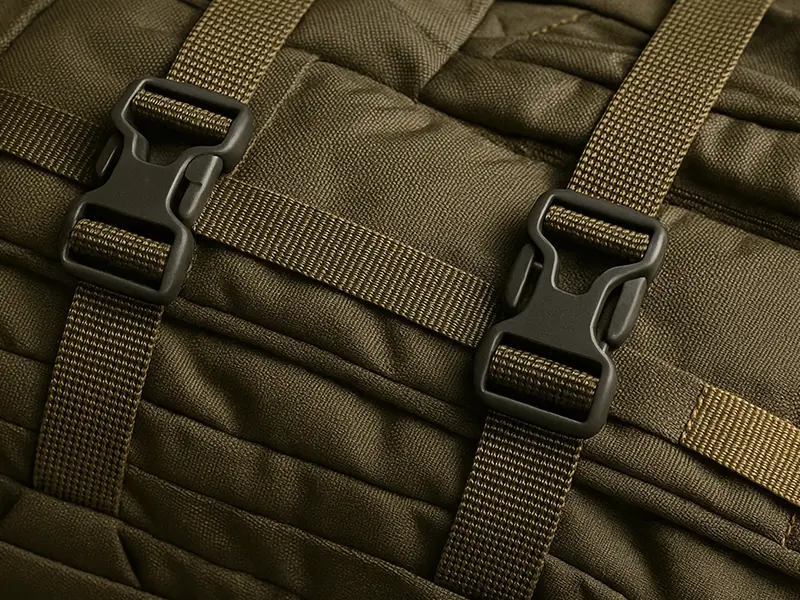In the world of outdoor gear, performance is paramount. A backpack failing on a multi-day trek or a tent guyline snapping in high wind isn't just an inconvenience—it's a safety risk. While consumers see the feature-packed final product, outdoor brands and manufacturers know that true durability often lies in the components. And few components are more critical, yet more overlooked, than webbing.
Choosing the right webbing material is a crucial design decision that impacts strength, weight, weather resistance, and ultimately, your brand's reputation. This guide leverages our manufacturing expertise to help you select the optimal webbing for any outdoor application, from heavy-duty backpacks to ultralight climbing gear.
1. The Workhorse of Backpacks: Straps, Loops, and MOLLE Systems
A backpack is arguably the most webbing-intensive piece of outdoor gear. Every strap serves a purpose, and each requires specific properties.
Shoulder Straps & Load Lifters: The Abrasion Fighters
For high-contact, high-abrasion areas like shoulder straps and hip belts, Nylon webbing is the undisputed champion. Its exceptional abrasion resistance ensures it won't fray or weaken under the constant friction of clothing and body movement. As we detailed in our Nylon vs. PP Webbing guide, choosing cheap PP for this application can lead to catastrophic failure. Nylon's slight inherent stretch also provides a degree of shock absorption, enhancing comfort under a heavy load.
Compression Straps & Gear Loops: Strength and Stability
The best webbing material for backpack compression straps and gear loops is typically also nylon, prized for its superior tensile strength. However, for brands focused on stability and minimal stretch (e.g., for securing heavy items), high-strength polyester webbing is an excellent alternative due to its lower elongation properties.
MOLLE Webbing: The Tactical Advantage
Originally designed for military use, MOLLE (Modular Lightweight Load-carrying Equipment) systems are now common on tactical and high-end outdoor backpacks. This grid of webbing allows for modular attachment of pouches and gear. This must be made from incredibly durable, solution-dyed material that adheres to strict mil-spec webbing standards to ensure consistent spacing and bombproof strength.
2. Weathering the Storm: Webbing for Tents, Tarps, and Shelters
When it comes to shelters, the primary adversary isn't abrasion, but the elements—specifically, UV radiation and water.
Tent Guylines & Stake Loops: The UV Resisters
This is where Polyester webbing shines. Unlike nylon, which can lose up to 30% of its strength after prolonged sun exposure, polyester is highly resistant to UV degradation. It also absorbs very little water, meaning it won't stretch or sag when wet, keeping your tent taut through a rainstorm. For added performance, a specialized UV-resistant finishing treatment can further extend the product's lifespan.
3. The Lifeline: Specialized Webbing for Climbing and Safety
In climbing, webbing is life-critical equipment. Material choice and construction are non-negotiable.
Tubular Webbing for Slings and Anchors
The standard for climbing runners and anchor systems is Tubular Nylon Webbing. Its construction—a flattened, hollow tube—makes it incredibly strong yet softer and more pliable than flat webbing, allowing it to hold knots securely. Its inherent dynamic properties (stretch) help to absorb some of the force from a fall, a critical feature detailed in our guide to safety webbing.
Ultralight Gear: The Rise of Dyneema® / UHMWPE
For alpine and ultralight applications where every gram counts, webbing woven with Dyneema® (an Ultra-High-Molecular-Weight Polyethylene, or UHMWPE) offers an unmatched strength-to-weight ratio. It's significantly stronger than steel by weight and is highly resistant to abrasion and UV rays. However, it is a premium material with a correspondingly higher cost.
Quick Selection Chart: Outdoor Webbing
| Application | Primary Recommendation | Key Properties |
|---|---|---|
| Backpack Shoulder Straps | Nylon Webbing | High Abrasion Resistance, High Tensile Strength |
| Tent Guylines / Stake Loops | Polyester Webbing | Excellent UV Resistance, Low Water Absorption |
| Climbing Slings / Runners | Tubular Nylon Webbing | High Strength, Knot-Friendly, Dynamic Properties |
| MOLLE Panels / Tactical Gear | Mil-Spec Nylon or Polyester | Extreme Durability, Strict Specifications |
Considerations for Eco-Conscious Outdoor Brands
Sustainability is a powerful purchasing driver in the outdoor community. We are proud to offer high-performance webbing made from rPET (recycled polyester), which uses post-consumer plastic bottles as its raw material. As explored in our guide to eco-friendly webbing, using certified rPET allows you to deliver the UV and water resistance your customers expect while significantly reducing your product's environmental footprint.
As a webbing manufacturer, we see firsthand how material choices made in the design phase translate to real-world performance. Specifying the right webbing—whether it's abrasion-resistant nylon for a pack or UV-stable polyester for a tent—is a fundamental step in building outdoor gear that earns customer trust and withstands the wild. Contact us to get a free sample and discuss the ideal webbing for your product line.

